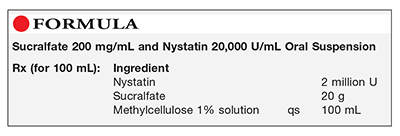US Pharm. 2017;42(1):56-57.

Method of Preparation: Calculate the quantity of each ingredient for the amount to be prepared. Accurately weigh or measure each ingredient or obtain the required number of sucralfate tablets. Triturate the powders or tablets and mix well. Add approximately 20 mL of the methylcellulose 1% solution to the powders to form a smooth paste. Add sufficient methylcellulose 1% solution to volume and mix well. Package and label.
Use: This preparation has been used in the treatment of ulcerations, erosions, and infections of the esophagus.
Packaging: Package in tight, light-resistant containers.
Labeling: Keep out of reach of children. Keep refrigerated. Shake well. Discard after ____ [time period].
Stability: A beyond-use date of 14 days when stored in the refrigerator may be used for this preparation.1
Quality Control: Assessments include weight and volume, pH, specific gravity, active drug assay, color, rheologic properties, physical observation, and physical stability (discoloration, foreign materials, gas formation, and mold growth).2
Discussion: Nystatin (mycostatin, C47H75NO17, MW 926.09) is a substance, or a mixture of two or more substances, produced by the growth of Streptomyces noursei (Streptomycetaceae). For extemporaneous preparation of oral suspensions, nystatin has a potency of not less than 5,000 U/mg. It occurs as a yellow to light tan powder with an odor suggestive of cereals. Nystatin is hygroscopic and is affected by long exposure to light, heat, and air. It is practically insoluble in water and in alcohol. Nystatin is used as an antifungal agent.1,3
Sucralfate (C12HmAl16OnS8) is the hydrous basic aluminum salt of sucrose octasulfate. It should be stored in airtight containers. Sucralfate is a cytoprotective drug. Under acidic conditions in the gastrointestinal tract, it combines with proteins to form an adherent complex that coats the gastric mucosa and is reported to have a particular affinity for ulcer sites. Sucralfate has also been used as a mouth rinse in the treatment and prophylaxis of cancer-induced stomatitis and mouth ulceration. Topically applied sucralfate has been used, with some success, to treat bleeding skin ulcers associated with malignancy and to promote the healing of venous stasis ulcers.4
Methylcellulose (Methocel) is a practically odorless and tasteless, white to yellowish-white granule or powder that is widely used in both oral and topical formulations. It is used at concentrations of 1% to 2% in suspensions. Methylcellulose is available in different viscosity grades, with the low-viscosity grades being used to emulsify oils and as suspending and thickening agents for oral liquids and the higher-viscosity grades being used to thicken topically applied products such as creams and gels. The pH of a 1% solution is in the range of 5.5 to 8.0. Instead of melting, methylcellulose begins to char at 280°C to 300°C. Methylcellulose is hygroscopic and is practically insoluble in acetone, ethanol, saturated salt solutions, and hot water, but it is soluble in glacial acetic acid. In cold water, methylcellulose swells and disperses to form a viscous, colloidal dispersion. Its solutions are stable to alkalis and dilute acids between pH values of 3 and 11. The viscosity of methylcellulose is decreased outside this pH range.5
Purified water is water that is obtained by distillation, ion exchange, reverse osmosis, or some other suitable process. Water has a specific gravity of 0.9971 at room temperature, a melting point of 0°C, and a boiling point of 100°C. Water is miscible with most polar solvents and is chemically stable in all physical states (ice, liquid, and steam).6
REFERENCES
1. U.S. Pharmacopeia/National Formulary [current revision]. Rockville, MD: U.S. Pharmacopeial Convention, Inc; December 2016.
2. Allen LV Jr. Standard operating procedure for performing physical quality assessment of ointments/creams/gels. IJPC. 1998;2:308-309.
3. Sweetman SC, ed. Martindale: The Complete Drug Reference. 36th ed. London, England: Pharmaceutical Press; 2009:543-544.
4. Sweetman SC, ed. Martindale: The Complete Drug Reference. 35th ed. London, England: Pharmaceutical Press; 2007:1596-1597.
5. Allen LV Jr. Methylcellulose. In: Rowe RC, Sheskey PJ, Cook WG, Fenton ME, eds. Handbook of Pharmaceutical Excipients. 7th ed. Washington, DC: American Pharmaceutical Association; 2012:496-499.
6. Dubash D, Shah U. Water. In: Rowe RC, Sheskey PJ, Cook WG, Quinn ME, eds. Handbook of Pharmaceutical Excipients. 7th ed. Washington, DC: American Pharmaceutical Association; 2012:880-884.
To comment on this article, contact rdavidson@uspharmacist.com.





